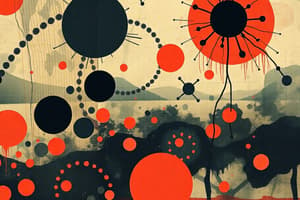Podcast
Questions and Answers
What are the two main components of a colloidal solution?
What are the two main components of a colloidal solution?
The dispersed phase and the dispersion medium.
What is the characteristic of the size of particles in a colloid?
What is the characteristic of the size of particles in a colloid?
They are too small to be individually seen with the naked eye.
How are colloids classified?
How are colloids classified?
According to the state (solid, liquid or gas) of the dispersing medium and the dispersed phase.
What is the dispersed phase in a colloid?
What is the dispersed phase in a colloid?
What is the dispersion medium in a colloid?
What is the dispersion medium in a colloid?
What is a characteristic of colloids in relation to heterogeneous mixtures?
What is a characteristic of colloids in relation to heterogeneous mixtures?
What is the type of colloid formed when a solid is dispersed in a liquid?
What is the type of colloid formed when a solid is dispersed in a liquid?
What is the term for the physical properties of matter that can be observed and specified?
What is the term for the physical properties of matter that can be observed and specified?
What is the difference between a physical change and a chemical change?
What is the difference between a physical change and a chemical change?
What is the type of colloid formed when a gas is dispersed in a solid?
What is the type of colloid formed when a gas is dispersed in a solid?
What is the term for a mixture in which two or more substances are mixed together, but not chemically combined?
What is the term for a mixture in which two or more substances are mixed together, but not chemically combined?
What is the type of colloid formed when a liquid is dispersed in another liquid?
What is the type of colloid formed when a liquid is dispersed in another liquid?
What is the basis for classifying substances as either elements or compounds?
What is the basis for classifying substances as either elements or compounds?
What is the type of colloid formed when a gas is dispersed in a liquid?
What is the type of colloid formed when a gas is dispersed in a liquid?
What is responsible for the scattering of light in the air?
What is responsible for the scattering of light in the air?
What is a suspension, and how does it differ from a solution?
What is a suspension, and how does it differ from a solution?
What is an example of a suspension, and what can be observed about its particles?
What is an example of a suspension, and what can be observed about its particles?
What is the Tyndall effect, and where can it be observed?
What is the Tyndall effect, and where can it be observed?
What is a characteristic of colloids that distinguishes them from suspensions?
What is a characteristic of colloids that distinguishes them from suspensions?
How can colloidal particles be separated from a mixture?
How can colloidal particles be separated from a mixture?
What is a characteristic of colloids that makes them stable?
What is a characteristic of colloids that makes them stable?
Why can't colloidal particles be separated from a mixture using filtration?
Why can't colloidal particles be separated from a mixture using filtration?
Flashcards are hidden until you start studying
Study Notes
Components of a Colloid
- A colloidal solution consists of two components: dispersed phase and dispersion medium.
- The dispersed phase is the solute-like component or dispersed particles in a colloid.
- The dispersion medium is the component in which the dispersed phase is suspended.
Properties of a Colloid
- A colloid is a heterogeneous mixture.
- The size of particles of a colloid is too small to be individually seen with naked eyes.
- Colloids are classified according to the state (solid, liquid, or gas) of the dispersing medium and the dispersed phase.
Types of Colloids
- Aerosol: liquid or solid dispersed in a gas (e.g., fog, clouds, mist, smoke, automobile exhaust)
- Foam: gas dispersed in a liquid (e.g., shaving cream)
- Emulsion: liquid dispersed in a liquid (e.g., milk, face cream)
- Sol: solid dispersed in a liquid (e.g., milk of magnesia, mud)
- Foam: gas dispersed in a solid (e.g., foam, rubber, sponge, pumice)
- Gel: liquid dispersed in a solid (e.g., jelly, cheese, butter)
- Solid Sol: solid dispersed in a solid (e.g., coloured gemstone, milky glass)
Physical and Chemical Changes
- Physical properties of matter can be observed and specified (e.g., colour, hardness, rigidity, fluidity, density, melting point, boiling point).
- Interconversion of states is a physical change because it occurs without a change in chemical composition.
- Substances can be classified as elements or compounds based on their chemical composition.
Suspensions
- A suspension is a heterogeneous mixture in which the solute particles do not dissolve but remain suspended throughout the bulk of the medium.
- Particles of a suspension are visible to the naked eye.
- Suspension is a heterogeneous mixture.
Tyndall Effect
- The Tyndall effect can be observed when sunlight passes through a colloidal solution.
- Colloids are big enough to scatter a beam of light passing through it and make its path visible.
Studying That Suits You
Use AI to generate personalized quizzes and flashcards to suit your learning preferences.




